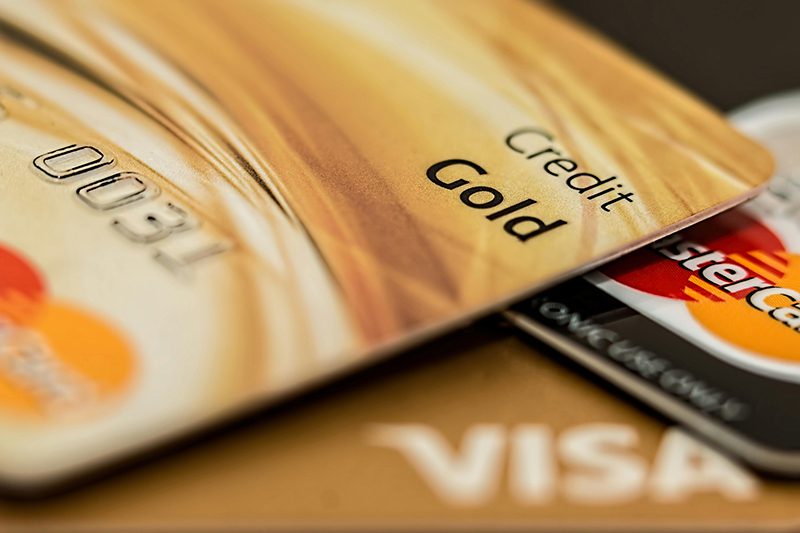Have you ever found yourself struggling to make a credit card payment and wondering if you could use another credit card to cover the balance? Many people ask this question, and the answer may not be as straightforward as you think.
At surface level, the answer is no. But like many things in life, there are a few loopholes you can use to pay a credit card with another credit card. We’ll cover those loopholes—and some alternatives—below.
Can You Pay a Credit Card With Another Credit Card?
You cannot pay a credit card bill directly with another credit card. Credit card companies typically do not permit this or consider it an accepted payment method.
However, there are some workarounds to this rule. If you’re looking for a way to technically pay a credit card using another credit card, there are two options you can consider:
Balance Transfer
A balance transfer lets you move the balance of one credit card onto another credit card, usually with a lower (or promotional) interest rate.
While you can transfer a balance to an existing credit card, the real benefit of this strategy is finding a new balance transfer card that offers a 0% APR promotional period. This way, you’ll get a leg up on paying down principal without worrying about the interest accruing. If much of your monthly payments are currently going toward interest, this can be a huge help in paying off the debt quicker.
Things to Consider Before Doing a Balance Transfer
- Balance transfers aren’t free: Most credit card issuers charge a balance transfer fee of 3% to 5% of the balance transferred. So, if you’re moving over a large amount of debt, you could be on the hook for an expensive fee added to your balance.
- You’ll need to switch issuers: Typically, you cannot initiate a balance transfer between credit cards from the same issuer. This means you’ll need to shop around a bit to research cards from different credit card companies that suit your needs.
- The promo APR window eventually ends: You won’t escape interest payments forever. According to CNBC, promotional 0% APR windows could last anywhere from six to 21 months. If you want to do a balance transfer, you should form a plan to pay off the debt as close to fully as possible within the promotional window.
- Your credit limit might not cover your debt: Just like any other type of credit card, balance transfer credit cards come with credit limits. These limits can vary based on your credit history, your income, and the policies of the credit card issuer. They may grant you a credit limit that isn’t large enough to cover the whole of your balance.
- You’ll need decent credit: According to Experian, balance transfer cards require good to excellent credit—which means a FICO score of 670 or higher. Note that applying for a new card will also appear as a hard inquiry on your credit report, which could further lower your score.
- No rewards: Balance transfers typically do not count as purchases. Therefore, if you’re transferring your balance to a rewards credit card, you likely will not earn any points for it.
Cash Advance
A cash advance is when you essentially borrow money against your credit card limit. You can do this by withdrawing cash from an ATM or by using convenience checks provided by the credit card company.
While convenient, cash advances usually come with high fees and interest rates compared to regular credit card purchases, and this is an overall expensive way to borrow money. It’s generally recommended to use cash advances as a last resort for the following reasons:
Things to Consider Before Taking Out a Cash Advance
- Interest rates are high: Cash advances typically have a higher APR than regular credit card purchases—sometimes much higher. According to Forbes, this could be as high as 29.99%.
- Fees can be high: Cash advances usually come with fees. A common fee structure is either $10 or 5% of the amount of the cash advance, whichever is greater. You may also be subject to ATM fees.
- No grace period: Unlike regular credit card purchases, interest on cash advances starts accruing immediately, with no grace period.
- No rewards: Like balance transfers, cash advances are not counted as purchases, and therefore are not eligible to earn any rewards points.

Pros of Paying a Credit Card With Another Credit Card
All in all, there are some benefits to using a credit card to help pay off another credit card. They include:
- Cash flow flexibility: Paying a credit card with another credit card allows for more flexible cash flow management. It can provide a temporary fix to cover expenses when funds are tight.
- Convenience: Consolidating multiple credit card balances into one, as you’d do with a balance transfer, makes it easier to manage debt. This can also potentially save you money on interest charges.
- Temporary relief: Using one credit card to pay off another may provide a temporary reprieve in managing your financial obligations until more funds become available.
Cons of Paying a Credit Card With Another Credit Card
On the other side, paying a credit card with another credit card comes with some drawbacks. These include:
- Incurring fees and interest: Both cash advances and balance transfers come with fees and stipulations about APR. Fees inevitably mean you will be adding to one balance while paying down another. As for APR, cash advances come with sky-high rates beyond what you’re charged for regular purchases. For balance transfers, some credit card issuers reserve the right to cancel your promotional APR if you’re late making a payment.
- Potential to increase debt: Using one credit card to pay off another can, if you aren’t careful, lead to a cycle of increasing debt. Cash advances come with high APRs and fees. Balance transfers should be paid off before the promotional 0% APR window closes. Otherwise, they can perpetuate the cycle and make it harder to pay off debt in the long run.
- Hit to your credit score: It’s reported that credit utilization makes up 20% to 30% of your credit score. In other words, you’re scored based on how much of your available credit you’re currently using. When you use one credit card to pay off another, you can raise your credit utilization ratio—lowering your score as a result.
6 Alternative Ways to Pay a Credit Card Bill
When it comes to paying off a credit card bill, you don’t necessarily have to turn to balance transfers or cash advances. There are various alternatives that can help you out of a tight spot.
By exploring these payment options, you may find a method that better fits your needs and lifestyle, making it easier to stay on top of your financial responsibilities.
1. Borrow Money From Someone
When in a pinch, borrowing money from friends or family members can be a good way to come up with the funds needed to make a credit card payment. Unlike traditional lenders, friends and family may be more understanding and willing to offer a loan without the need for a credit check or collateral.
It’s absolutely vital to approach the situation with honesty and humility. Clearly communicate the reason for needing the loan and present them with a plan for repayment. Establishing these details shows responsibility and commitment to honoring the agreement, which can help maintain trust and prevent strain on the relationship.
Once the terms are agreed upon, it’s important that you stick to the plan and make timely payments. Failing to do so could not only damage your relationship but also impact your financial reputation.
While borrowing money from friends or family can provide a quick fix for a looming credit card bill, you should use this option very sparingly. Open communication, clear terms, and a commitment to paying them back will be essential components for this to work.
2. Take Out a Personal Loan
If you have a large credit card bill or a significant amount of credit card debt, taking out a personal loan can be another option to consolidate and pay off your debt. Personal loans often have lower rates than credit cards, so you can save money on interest payments by transferring your debt to a personal loan.
Before you go for this option, you’ll want to make sure that you can secure a personal loan with a lower interest rate than your credit cards. It’s also important that you’re able to make regular, on-time payments on the loan. Finally, you’ll want to consider the terms and fees associated with the personal loan to make sure that it’s a cost-effective option for you.
To get a personal loan, you’ll need to have a good credit score, stable income, and a low debt-to-income ratio. Lenders will also consider your employment history and other financial factors when deciding whether to approve your loan application. You can apply for a personal loan through banks, credit unions, or online lenders. Shop around and compare offers to find the best interest rate and terms for your situation.
3. Find a New Income Source
Finding a new income source is one of the best ways to tackle any kind of debt. By increasing your income, you’ll have more funds available to pay your credit card bills on time, which can help you avoid high interest charges and late fees.
Whether it’s finding a part-time gig, freelancing, starting a side business, or asking for a raise at your current job, having a higher income means you’ll have more money to allocate towards your credit card debt. It also means you’ll be better able to afford paying your credit card bills on time, which can help improve your credit score—as on-time payments are a key factor in determining your creditworthiness.
With a higher income, you’ll also have greater financial flexibility and be less likely to rely on credit cards in the first place. This will reduce your risk of accumulating more debt.
4. Slash Your Budget
If you find yourself stuck with a credit card bill or a large amount of credit card debt, one of the first steps you should take is to carefully examine your budget. Look for expenses that you can slash or pause in order to allocate more funds towards paying off your credit card.
Start by reviewing your monthly expenses and see where you can cut back. This could mean dining out less frequently, reducing non-essential spending on entertainment, or finding ways to lower your utility bills. You might also consider pausing any subscription services like streaming platforms, gym memberships, or other recurring expenses that are not critical to your daily life.
By reallocating money towards paying off your credit card debt, you can make a significant impact on reducing your balance and saving on interest in the long run. Creating a realistic budget and sticking to it can help you regain control of your finances and work towards becoming debt-free.
Remember that this is a temporary measure to help you tackle your debt; once you’ve paid off your balance, you can reevaluate and gradually reintroduce some of those paused expenses.

5. Sell Your Stuff
If you need to quickly come up with cash to pay a credit card bill, one option is to sell some of your belongings or old, unused stuff. Start by taking inventory of items that you no longer need or use; this could be clothes, electronics, furniture, or appliances. You can consider selling them through channels like eBay, Craigslist, or Facebook Marketplace—or even through a garage sale.
After your items have been sold, use the proceeds to make a payment towards your credit card bill. This approach lets you declutter your space while quickly generating the cash you need to square away your financial obligations.
6. Talk to Your Credit Card Issuer
If you’re struggling to pay your credit card bill, reach out to your credit card issuer as soon as possible to discuss your situation. They may be willing to help by negotiating a payment plan—especially if you’re experiencing financial hardship. You can usually find the customer service phone number on the back of your credit card or on your monthly statement.
When calling your credit card issuer, be prepared to explain why you’re having difficulty making payments. Make sure you have a clear understanding of your monthly income and expenses and be able to provide documentation if necessary.
Be polite and remain level-headed during the conversation. Explain that you are committed to repaying your debt and ask if they can work with you to create a manageable payment plan. Be prepared to propose a specific amount that you can afford to pay each month and ask if they can lower your interest rate or waive any late fees to help make the payments more affordable. Remember, the goal is to find a solution that works for both you and the credit card issuer.

